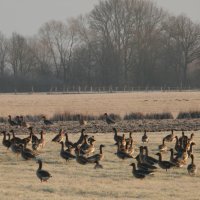
Agriculture
About two-thirds of the area of the biosphere reserve are put to agricultural use. Of this, about half is arable land mostly made up of dyked marshland. The main crops are winter grain and winter rape. Over the last few years maize has been on the increase because of the energetic value of its biomass, which makes it very suitable for the production of biogas.
These crops are also a welcome source of food for large numbers of birds which migrate from much further north. Farmers whose crops are damaged by the birds can enter into contractual arrangements with the nature conservation authorities. They receive compensation payments in exchange for implementing special farming methods and tolerating the presence of the visiting birds.
About ten percent of the agricultural land in the biosphere reserve is still subject to direct flooding from the Elbe. These floodplains and other areas of the marshes with a high ground water level are used more or less intensively as grassland. In the main, the meadows are mown two or three times a year.
Here, too, the biosphere administration authority offers the farmers financial incentives to implement farming methods which lessen the agricultural impact on the environment and promote or maintain the typical diversity of the valley flora.
Organic farming is becoming an increasingly important alternative to conventional farming. Since 1998 the number of farms operating according to the principles of organic farming has increased more than fourfold, and they now account for about six percent of the total within the districts of Lüneburg and Lüchow-Dannenberg.

Farmers receive compensation payments in exchange for tolerating the presence of the visiting birds.



 deutsch
deutsch english
english